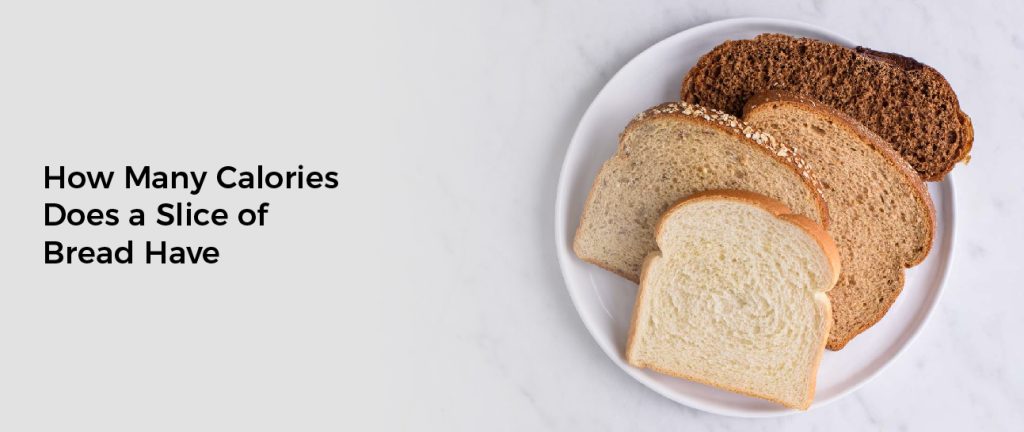Calories are often top of mind when it comes to a balanced diet. And while there’s no one-size-fits-all answer regarding how many calories you should be eating each day, understanding the nutritional content of different foods can help you make informed choices about what you put into your body. So, let’s talk about something that’s a staple in most pantries and lunchboxes bread. Furthermore, nothing beats freshly baked bread when it comes to making sandwiches or adding some heft and texture to a light meal. But just how much energy does this dietary staple provide? We’ll explore this question in more detail with today’s blog post as we examine how many calories does a slice of your favorite bread variety!
What are Calories?
Calories are a unit of energy. This energy is measured by the quantity of food and drink we consume, which provides us with fuel to sustain our daily activities and growth.
How Many Calories Are in A Slice of Bread?
| Bread Slice Thickness & Type | Average Weight Per Slice | Average Calories Per Slice |
| Thin Slice | 22-25g/0.8-0.9oz | 45-60kcal |
| Medium Slice | 25-30g/0.9-1.1oz | 60-75kcal |
| Thick Slice | 30-40g/1.1-1.4oz | 75-90kcal |
| Extra-Thick Slice | 40-50g/1.4-1.8oz | 90-110kcal |
It depends on what kind of bread it is – white, wheat, sourdough, etc. On average, a slice of bread has about 80-100 calories. The calorie count may also be higher for artisan or whole wheat varieties, depending on the ingredients used. So, if you’re counting your calories and watching your food intake, it’s a good idea to check the label before eating a slice of bread. That way, you can be sure you’re getting the right number of calories for your needs.
The Calorie Content of Different Brands of Breads
Different bread brands can vary in calorie content, with some having more calories than others. For example, a loaves of white bread from a major brand contains about 70 calories/slice, while the same size loaves of wheat bread has around 90 calories. Sourdough bread tends to be higher in calories, with one brand offering 120 calories/slice.
1. Great Value Bread Calories
| Great Value Bread Type | Average Weight Per Slice | Calories Per Slice |
| Great Value White Sandwich Bread (20oz loaf/24 slices) | 23.5g/0.83oz | 60kcal |
| Great Value Wheat Sandwich Bread (20oz loaf/22 slices) | 25.5g/0.9oz | 60kcal |
| Great Value White Round Top Bread (20oz loaf/22 slices) | 25.5g/0.9oz | 70kcal |
2. Natures Own Bread Calories
| Natures Own Bread Type | Average Weight Per Slice | Calories Per Slice |
| Natures Own Butter Bread (20oz loaf/22 slices) | 25.5g/0.9oz | 70kcal |
| Natures Own 100% Whole Wheat (20oz loaf/22 slices) | 25.5g/0.9oz | 60kcal |
| Natures Own Perfectly Crafted Thick Sliced White Bread (22oz loaf/15 slices) | 42g/1.5oz | 110kcal |
3. Oroweat Bread Calories
| Oroweat Bread Type | Average Weight Per Slice | Calories Per Slice |
| Oroweat Whole Grain Oatnut Bread (24oz loaf/16 slices) | 42.5g/1.5oz | 120kcal |
| Oroweat Whole Grain Oatnut Small-Slice Bread (18oz loaf/18 slices) | 28g/1oz | 80kcal |
| Oroweat Country Style Buttermilk Bread (24oz loaf/16 slices) | 42.5g/1.5oz | 100kcal |
Advantages of Different Loaves of Bread
1. Whole-Grain Bread Is Healthier Than White Bread
When it comes to whole grain bread, you’ll find that it is healthier than white bread. This is because it contains more fiber and more protein. Those two features help keep blood sugar levels steady.
Whole-grain bread also contains healthy omega-3 fats. These nutrients are crucial to your body’s digestive system. They reduce your risk of type 2 diabetes and colon cancer.
The second healthy advantage of whole-grain bread is its low GI (glycemic index). The glycemic index is a measurement of how quickly glucose enters your bloodstream. Generally, the more fiber a food has the lower its GI.
It is a good idea to read the label on your bread. Many loaves of bread contain added sweeteners and fats.
You can’t always depend on what is on the label to make a healthy choice. For example, some loaves of bread are made with vegetable oils containing omega-6 fats. Although they’re not bad for you, they’re not great for your heart.
2. Nut Butter Is A Healthy Spread
Peanut butter is the most popular nut butter in the United States. It provides a lot of benefits, but it also has a reputation for being high in fat.
Nut butter is a healthy spread that is great for breakfast or a snack. It is a good source of protein and has many health benefits. There are several types of nut butter, including peanut butter, cashew butter, sesame seed butter, and nut butter made from coconuts.
If you’re looking for a more balanced diet, you may want to look for nut butter with a low amount of saturated fat. However, if you are concerned about your health, opt for nut butter with natural oil separation.
3. English Muffins Are A Low-Calorie Bread Option
If you are looking for a low-calorie bread option, English muffins might be the right choice. They are a great source of complex carbohydrates. This means they provide a sustained energy boost. And they’re also good for your health.
They can be a great way to get the fiber you need. Fiber helps keep you full for longer. In addition, it can prevent constipation. Plus, it can help stabilize your blood sugar levels.
Compared to white bread, whole-grain English muffins tend to have a higher nutrient content. The whole wheat version is rich in fiber, magnesium, calcium, and selenium. It also contains fewer calories and less fat.
These baked goods are a popular choice for breakfast. But they don’t have to be limited to the morning meal. You can enjoy them as a tasty side dish or sandwich throughout the day.
4. WarburtonsMedium-Sliced White Bread Has 98 Calories
Warburtons is the largest bread brand in the UK, andits sliced white bread is packed with protein and carbohydrates. This particular product has 98 calories per slice. That means that two slices of the product can make a full-sized sandwich. You can add a few fresh salad leaves to your sandwich to boost its nutritional value.
While white bread isn’t exactly healthy, it is a better choice than other options on the market. Some other brands of sliced white bread have higher fat and sugar content. Thankfully, you can get a healthier choice at Tesco. They have sliced white bread packed with 7.4g of protein and just 2.0g of fat per 100g of bread. Plus, it is packed with plenty of vitamins and minerals too.
Conclusion
As you can see, the calories in a slice of bread vary greatly. It all depends on the type of bread you select and your serving size. If you’re looking for a healthier option with fewer calories, whole grain or sprouted grain varieties can be better than white or regular wheat bread.
Additionally, reducing your serving size is an excellent way to help manage your caloric intake while still enjoying the flavor of your favorite type of bread. When it comes down to it, however, knowledge is power: being informed about what you’re consuming and how many calories are in that food can help you make the healthiest choices when selecting which types and portions of foods to eat. After all, details matter!


